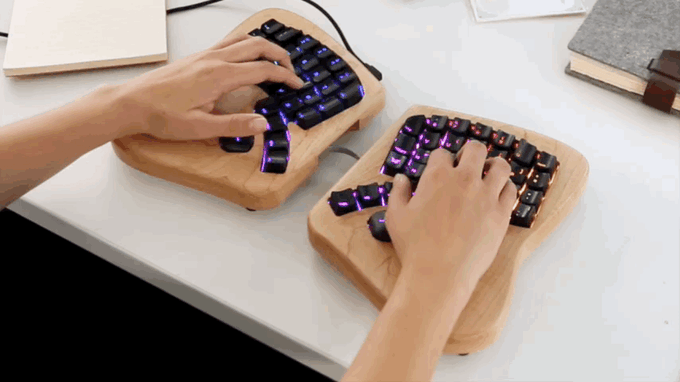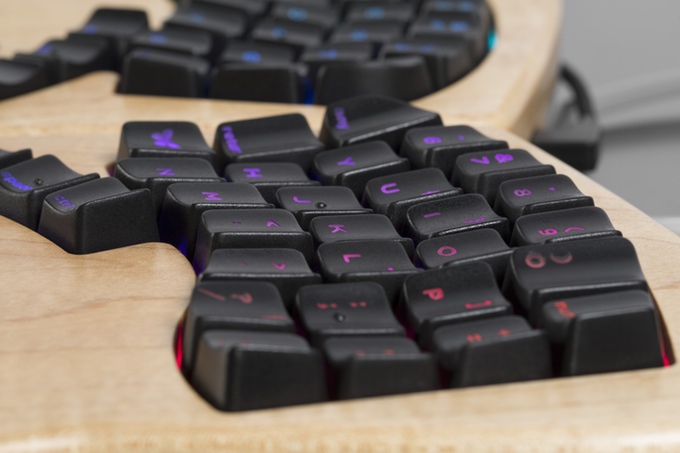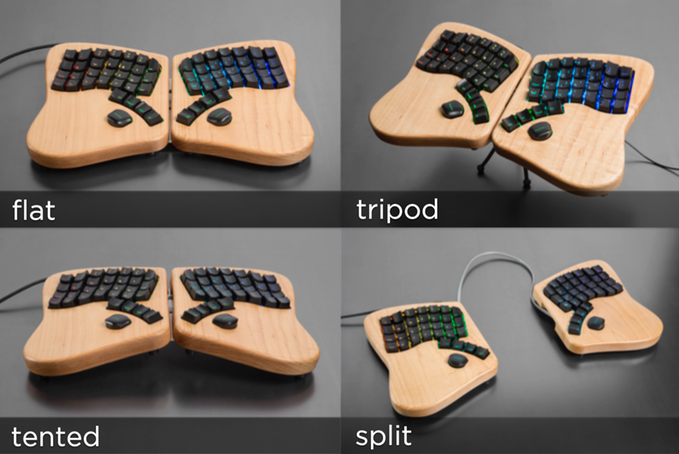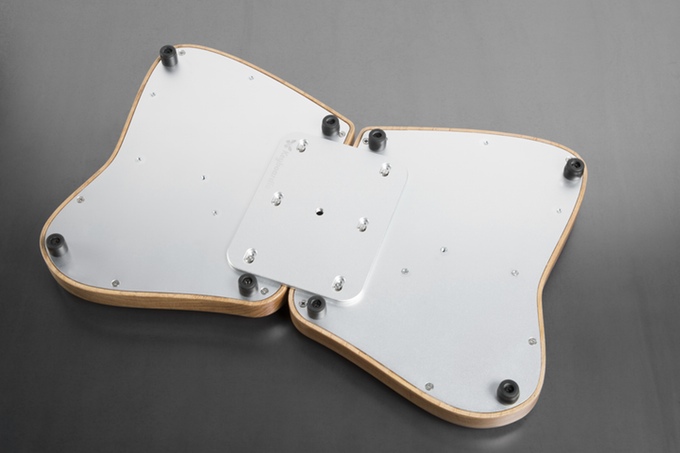Keyboardio's Wooden Model 01 Mechanical Ergonomic Keyboard Kickstarter Soaring
Mechanical keyboards are a big thing now, but nobody seems to make a good and easy-to-use ergonomic version. Keyboardio is here to change that, bringing more to the table than a quick ‘n easy attempt.
The Kickstarter for the Keyboardio Model 01 launched just over two weeks ago, and since then it has had a very successful run. It still has 13 days to go before the campaign ends, so if you're quick you may just be able to get yourself a keyboard – there are no limits to the number of backers.
The founders of Keyboardio call the Model 01 "an heirloom-grade keyboard for serious typists." The idea behind the keyboard is simple: be the most ergonomic keyboard ever made, and make no sacrifices on the way, creating a one-of-a-kind experience.
The Model 01 has been in development for 2.5 years, and during this time the designers have gone through many iterations of the keyboard, settling on a butterfly-like appearance. The butterfly look was accidental; they wanted to create something ergonomic, and the shape just sort of emerged. But they liked it, and so a butterfly also became part of the logo.
The keyboard's base is made of two slabs of maple wood, which you can attach together with a brace, or you can keep the two pieces separate. According to the designers, using plastic just didn't feel right, so they went with wood for a more natural material feel.
Keyboardio opted to use non-clicky, tactile, mechanical switches from the Canadian manufacturer Matias. They are called Quiet Click switches, and Matias claims that they are the world's quietest mechanical keyswitches, with more tactile feedback than Cherry's MX mechanical switches. The housings of these switches are transparent with RGB lighting support. As it turns out, all of Matias switches are clear, allowing the keyboard maker to integrate their choice of LED-lighting.
The tactile curve of these switches is quite different from Cherry switches. At 1.9 mm down on the travel path, there is a tactile bump that takes 60 grams of pressure to get through. After the bump, the actuation point is 2.2 mm from the top. The switches bottom out after the tactile bump with a force of 35 grams, 3.5 mm from the start of the keypress. Each switch has a mean-time between failure (MTBF) of 50 million keystrokes.
The brain inside the keyboard is an ATmega 32U4 microcontroller, which is the same one featured in the Arduino Leonardo. The team intended to switch to an ARM-based microcontroller later on, but the Arduino IDE makes programming so easy that they opted to stick with Arduino. (It's nice for modders, too!)
Get Tom's Hardware's best news and in-depth reviews, straight to your inbox.
If you want to back the project and get a keyboard, it'll cost you $299. Of course, you can give less, but you won't get a keyboard. If you pay $10 more, you can get premium tactile switches with an audible click. Included with the two halves of the keyboard are two connecting braces, the source code for the microcontroller, and a screwdriver so that you can open the keyboard up and tinker around inside it.
The team estimates delivery will take place in April 2016. Considering how successful the Kickstarter appears to be, it is possible that there will be some delays due to the increased number of keyboards that need to be manufactured.
Update, 7/02/15, 2:36pm PT: The article was corrected to clarify that Matias builds its switches with RGB lighting support. The actual LED for the LED-lighting has to be integrated by the keyboard maker.
Follow Niels Broekhuijsen @NBroekhuijsen. Follow us @tomshardware, on Facebook and on Google+.
Niels Broekhuijsen is a Contributing Writer for Tom's Hardware US. He reviews cases, water cooling and pc builds.
-
uglyduckling81 So you need to buy a separate numpad? I've never liked that split design. My friend has used one of those goofy MS split boards for 15 years. It's just horrible to try and play on his PC.Reply -
tom10167 It is for typists and/or people with wrist problems. It looks pretty good, though if you truly hold your hands in the most natural shape, the keys would be almost vertical and facing away from the user. "Tented" is the closest to this but still not close to perfect.Reply -
softskilled well this would not make the first ergonomic mech. switches keyboard but the second, since matias is already making it http://matias.ca/ergopro/pc/ . I just ordered it a couple of days ago since I have problems with my wrists (I already have the laptop pro version, very nice one).Reply -
merikafyeah The KeyMouse is better than this in practically every way:Reply
https://www.kickstarter.com/projects/1666150716/keymousetm-the-keyboard-and-mouse-re-invented/description
Additionally, the KeyMouse solves the fundamental keyboard-mouse switching problem which makes it a revolutionary step in computer input devices on par with the development of the keyboard and mouse themselves, which have remained fundamentally unchanged for decades.
The KeyMouse is the reason why I no longer care about articles on company's new mechanical keyboard offerings or some new-fangled gaming mouse because I have finally found computing input perfection. The only thing that could be better than the KeyMouse would be another "keymouse-type" device but that is highly unlikely seeing as how the KeyMouse team has gotten everything right, which is something I pretty much never say. Every feature I could want is there from backlighting to mechanical switches to fully customizable software, even Dvorak can be chosen as an option, and I have no complaints or concerns regarding the physical design which, from watching the various demo videos, seems to have a very minimal learning curve
Needless to say I am a backer of the KeyMouse and development is very close to finished. It's now basically refining tweaks and sorting the suppliers for mass-production. The estimated MSRP is approx. $350 but to me that's a small price to pay for perfection. -
softskilled Reply16179375 said:The KeyMouse is better than this in practically every way:
shamelessly long advert aside, it doesn't support tenting already so it is not better in practically every way. I like the possibility of using it as a mouse, but would be probably better if it had an adjustable hand rest. Anyway I'm sure there is a market for it, so good luck! I still think I took the right decision regarding the matias keyboard, which I plan to use with a trackpad between the two halves. -
softskilled Reply16200351 said:One word: Maltron.
thanks, technologically awesome, but doesn't seem to get as much love being made as the matias ergonomic one. I'll keep it in mind in case I ever need a really specialised keyboard. -
merikafyeah Reply16179375 said:shamelessly long advert aside, it doesn't support tenting already so it is not better in practically every way. I like the possibility of using it as a mouse, but would be probably better if it had an adjustable hand rest. Anyway I'm sure there is a market for it, so good luck! I still think I took the right decision regarding the matias keyboard, which I plan to use with a trackpad between the two halves.
While you cannot tent the KeyMouse, not having to constantly switch between keyboard and mouse hundreds or thousands of times a day is a much bigger ergonomic plus than simply tilting the two halves a few degrees. Also, being able to use the two halves as far apart as you want greatly mitigates the need for tenting.
The KeyMouse DOES have an adjustable hand rest (and a lot more I didn't mention). If you watched the Kickstarter video you'd know. I did provide a link to the campaign.
Of course there's a market for it. It consists of everyone who is tired of constantly switching between keyboard and mouse, not to mention all the other fields mentioned in the campaign, in other words, the exact opposite of a niche market. People just never thought an alternative existed until now.
Not sure why you're wishing me good luck since I don't think I'll have much difficulty buying a KeyMouse when it is available, though there is always a chance they might be sold out really quickly so there's that.
Trackball edition is planned but no definitive timetable until after the core product is finished. -
softskilled hi merika,Reply
I wouldn't have replied without analysing the material you posted. The hand rest is not adjustable really, it is actually just fittable to different hand types - the position of the hand stays the same. I think I'd love it if I had healthy hands. I also think it should have way less buttons.
I meant it when wishing you good luck.
Let's see when it's out, I hope it's successful. -
uglyduckling81 I don't want to be negative on it but that keymouse looks like an awful experience.Reply
Your talking it up sounds like people bashing on about how amazing a trackball is over a mouse. Guess what... it's also a terrible peripheral.
I could see the keymouse maybe getting some traction in an office enviroment but it's never going to be adopted for gaming purposes.
There does become a point in which you over saturate the working area of the hands. The Keymouse is overly complicated in my opinion.
It's the reason why we don't have a fridge, oven, dishwasher, mircrowave, hot water system combo device. Sometimes having an item specialised to it's job is just more efficient and a better user experience over all.
I can buy a mouse now with 20-30 buttons on it but I don't because I want my mouse to be uncomplicated and do a really good job as a mouse.




